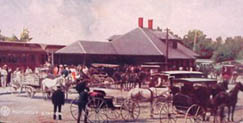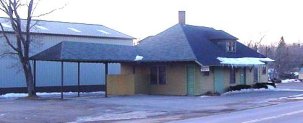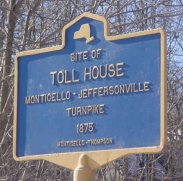The old Newburgh-Cochecton Turnpike was a primary means of travel through early Sullivan County. Raftsmen heading back from the Hudson River at Newburgh walked or rode up the turnpike to shepherd more log rafts down the Delaware. Another main road that cut through Monticello was the Monticello-Jeffersonville Turnpike. A toll-house on what is now Jefferson Street charged six cents to horse and carriage riders, 12 cents for a team of horses, and more for cattle drivers was the going rate. The tollhouse was demolished in 1960 after falling into disrepair. The site, which presently sports a picnic table for road-side rests, was marked with the sign at the left at a public ceremony in August 1995. [1]
Route 17B follows the route of the old Newburgh-Cochecton Turnpike, which started in Cochecton, followed County Road 114, which becomes Route 17B in Fosterdale. The route ran through Monticello, the present-day terminus of Route 17B, then followed what is now Old Route 17 until Bloomingburg onto the current Route 17K. Route 17K runs the entire rest of the old Newburgh-Cochecton Turnpike until its terminus in Newburgh. Looking at a map you will see the almost straight line from Cochecton to Newburgh along this old plank route. The old turnpike was chartered on March 20, 1801 in an effort to connect both the Hudson and Delaware Rivers, and to provide access to mostly unsettled land northwest of Newburgh. The only stretch of Route 17B that is not along the alignment of the old Turnpike is from Fosterdale to Callicoon, where the state route designation turns northwest. Driving straight throught the blinker light in Fosterday will take one along to the terminus of the old turnpike, just upriver from Skinners Falls on the Upper Delaware.
The Iron Horse Draws Nigh

The Monticello & Port Jervis Railroad Company was organized under the General Railroad Act of the State on September 2, 1868. The track was laid to Monticello (the northern terminus) and the cars first entered the village about the first of January 1871. The county seat was now easily accessible by rail, and more and more people travelled to Monticello to enjoy the healthful climate and beautiful country.

An old dwelling was converted into a station after the completion of the railroad. This did service until the Ontario & Western Railroad became owners of the branch and replaced the old station with a modern new structure. David Watkins was the ticket and station agent in 1872; then Frank A. Starr served for many years as the agent. [2]
The second of the above two photos, taken in February 2001, shows the station as it is today. Currently, the building is used by Van Etten Oil Company. The former abandonded railroad bed has been converted to recreational trails as part of the Rails-to-Trails Conservancy.
Horseless Carriages
"The various forms of the new vehicle generally called the automobile are steadily coming into vogue and it need occasion no surprise to the traveller on the highway to meet one of these anywhere at any time," remarked the Ellenville Journal on January 5, 1901. By that time enterprising people were talking of the possibility of running "motor stages" to link towns bypassed by the railroads to railroad stations; a Monticello and White Lake to Fallsburgh line was being rumored. By the next year local newspapers were reporting that gypsies were concocting motor-powered vans. [3]
Jeff Smith of Monticello, newsletter editor of the Catskill chapter of Antique Automobile Club of America, states that his wife Susan Smith knew the late Herb and Gussie Branch of Monticello, who claimed that Herb's father owned the first car dealership in Monticello, approximately in the 1920s. "Herb recalled before the dealership, used horse and buggy to get milk from farms, and after the dealership they didn't. The dealership most likely also sold farm trucks and equipment", Mr. Smith said.
"In an unrelated note", he added, "there was a car dealership called the Art Carroll dealership which was located in the building now occupied by the J.C. Penney catalog store. It sold Plymouth and DeSoto and went out of business about 1962." [4]
"The 1950s and 1960s were the heyday of the borscht circuit. The postwar boom spurred hotel expansion and widespread car ownership, and more people could afford vacations. In 1952 the hotel association census counted 509 hotels and boarding houses in Sullivan County. In 1957 the Route 17 Quickway was completed, making the Catskills only 90 minutes away from New York City. This led to a new boom, with expansion of pools, nightclubs, sports facilities, phone wiring, and deluxe accomodations. In 1958 Monticello Raceway was built by a consortium that included many top hotelowners (Kanfer 1989, p. 237)." [5]
At the present time (February 2001), efforts are underway to change the designation of the Quickway (NYS Route 17) to I-86 in order to bring greater visibility and access to the region.
[3] Alf Evers (1972). The Catskills: From Wilderness To Woodstock, New York: Doubleday & Co., p. 685.
[4] Jeff Smith (2001). E-mail dated February 19 and 21, 2001






